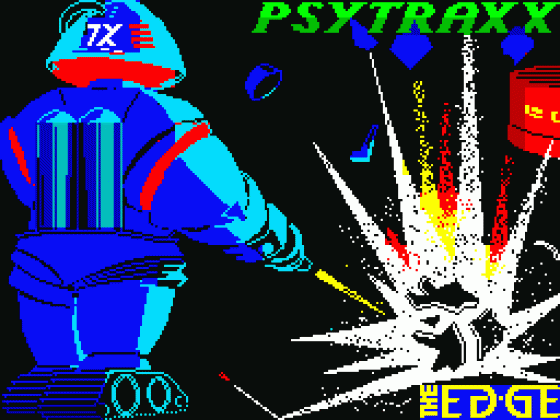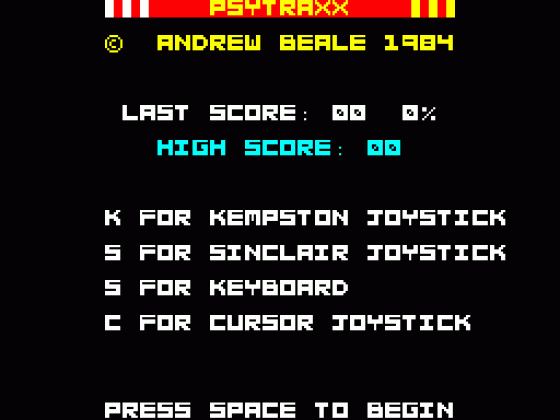Psytraxx
Psytraxx is said by its producers to be the second true mega-game, the first having been their C64 game Quo Vadis? "Now Spectrum owners can experience the fruits of our unbelievable synergy programming techniques, says the PR. No one at Crash is entirely sure just what 'synergy' is when it's at home, or how it makes Psytraxx different from any other similar game type; and in as much Starbike looks uncannily like Atic Atac. You have a very large number of rooms, a wandering and questing hero and numerous manifestations of monsters, plus useful items to pick up on the way. As in Atic Atac, it it up to the player to discover how to do what, and what to do with it when you've got it.
Psytraxx takes place inside that ever popular location, a computer. You are in control of a Microdroid and the object is to do battle with the nuts and bolls of its innards (diodes, chips and the like) while trying to gain access to a CPU by collecting the Key Cards. To keep your spirits up there are little green blocks in each room visited that charge you up so you can fire at and destroy the nasties, although in each life, once eaten the cake is gone. There are only five rooms (all framed in printed circuitry) at the start that you can visit without problem since the last is blocked off by a purple and a blue force field over two exit doors. Collecting the key card a few rooms before, however, will gain you access to the next area which is much larger. The Edge claim that there are over 1,060 screens to play through, and as our reviewers discovered, the game isn't as straightforward as it first seems.
Criticism
Psytraxx is definitely an Atic Atac look-alike, a sort of arcade adventure in which you must obviously find out how all the various elements are linked in order to see a way through. it's a constant fight against the nasties and a battle to keep the energy up as contact with any of the fixtures in the rooms drains you rapidly, and once that's gone you have no defence against the diodes and resistors until another power pack is found. Each of the key cards found seems to allow you access to further parts of the complex, but there are puzzles too. What is the chip with or on it? Touch it and you dissolve to be reformed, but the chip that was yellow is now white and all the rooms that were once white are now yellow. Repeating the process reverses the phenomenon. Is it useful? This and many other questions will no doubt be answered in the forthcoming weeks! I found Psytraxx extremely playable and challenging. It's obviously a much larger game than Atic Atac, but the graphics are nowhere near as attractive and as far as I can determine at this state of play, there isn't actually as much to do either. Still, a worthwhile buy, and I'll give it the benefit of the doubt that the further in you get the more complicated play becomes, lust as it did with the first three levels.

This game from The Edge is similar in general game idea to Atic Atac (but not as good by far). Generally the game is okay, with all the nasties (chips, diodes etc) looking quite good. But on my encounter I would hardly call it a mega-game; in fact it was a bit on the synergy side.
I know hype is important when it comes to grabbing attention, but I think The Edge have well and truly overdone it with Psytraxx. I'm not saying that it isn't an interesting game, but if this is a true mega-game then I haven't much hope left for Spectrum advances. Let's face it, with all the nonsense about "synergy" programming techniques, what we have here is a pale shadow of Atic Atac, but completely without the charm of that game. I was vaguely reminded as well of Softek's Microbot, which I thought was a much better game than Psytraxx. The graphics here aren't bad, the animation of the various enemies is reasonable but the 1,000 plus rooms are pretty boring to look at. I guess this is another "map" game, as you can quickly become lost in the maze, but an important part is such games is that the locations should all have something to give them identity. Psytraxx lacks sadly in this respect. Because of this, I didn't find it particularly addictive.
Comments
Control keys: A/Z up/down, O/P left/right, Q-T pick up and drop
Joystick: Kempston, Sinclair, AGF, Protek
Keyboard play: responsive 8-directional movement
Use of colour: above average
Graphics: reasonable size and detail, fast and fairly smooth
Sound: useful beeps and some effects, otherwise not much
Skill levels: 1
Lives: 3
Screens: over a 1000
General Rating
A large-sized game which was generally felt to be above average to good, but over-priced.
Other Reviews Of Psytraxx For The Spectrum 48K
Psytraxx
A review by Bob Chappell (Personal Computer News)
Psytraxx (The Edge)
A review by B.B. (Home Computing Weekly)
Psytraxx (The Edge)
A review by Bob Wade (Personal Computer Games)


 1st November 1984
1st November 1984





